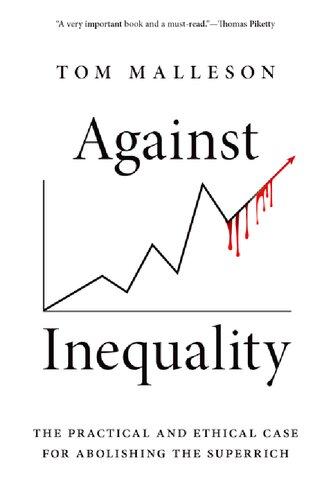Risk Modeling: Practical Applications of Artificial Intelligence, Machine Learning, and Deep Learning Terisa Roberts
https://ebookmass.com/product/risk-modeling-practical-applications-ofartificial-intelligence-machine-learning-and-deep-learning-terisaroberts/
ebookmass.com
Against Inequality: The Practical and Ethical Case for Abolishing the Superrich Tom Malleson
https://ebookmass.com/product/against-inequality-the-practical-andethical-case-for-abolishing-the-superrich-tom-malleson/
ebookmass.com
Fated Enemies: The Bloodmoon Series Book 6 Alisandra


https://ebookmass.com/product/fated-enemies-the-bloodmoon-seriesbook-6-alisandra/
ebookmass.com
Forms and Structure in Plato's Metaphysics Anna Marmodoro

https://ebookmass.com/product/forms-and-structure-in-platosmetaphysics-anna-marmodoro/
ebookmass.com
A Cowboy State of Mind 1st Edition Jennie Marts
https://ebookmass.com/product/a-cowboy-state-of-mind-1st-editionjennie-marts/
ebookmass.com



7-2 Consistency or Adaptation? 208
7-3 Forms for Global Business 209
7-3a Exporting 210
7-3b Cooperative Contracts 210
7-3c Strategic Alliances 211
7-3d Wholly Owned Affiliates (Build or Buy) 212
7-3e Global New Ventures 212
7-4 Finding the Best Business Climate 213
7-4a Growing Markets 213
7-4b Choosing an Office/Manufacturing Location 214
7-4c Minimizing Political Risk 215
7-5 Becoming Aware of Cultural Differences 216
7-6 Preparing for an International Assignment 218
7-6a Language and Cross-Cultural Training 218
7-6b Spouse, Family, and Dual-Career Issues 219
Management Team Decision 222
Practice Being a Manager 222 Self-Assessment 223
Management Workplace 228
8 Designing Adaptive Organizations 232
What Would You Do? 232
8-1 Designing Organizational Structures 233
8-2 Departmentalization 236
8-2a Functional Departmentalization 237
8-2b Product Departmentalization 238
8-2c Customer Departmentalization 239
8-2d Geographic Departmentalization 239
8-2e Matrix Departmentalization 241
8-3 Organizational Authority 244
8-3a Chain of Command 244
8-3b Line Versus Staff Authority 244
8-3c Delegation of Authority 245
8-3d Degree of Centralization 246
8-4 Job Design 247
8-4a Job Specialization 248
8-4b Job Rotation, Enlargement, and Enrichment 248
8-4c Job Characteristics Model 249
8-5 Designing Organizational Processes 253
8-6 Intraorganizational Processes 254
8-6a Reengineering 254
8-6b Empowerment 256
8-6c Behavioral Informality 257
8-7 Interorganizational Processes 259
8-7a Modular Organizations 259
8-7b Virtual Organizations 260
Management Team Decision 262
Practice Being a Manager 262 Self-Assessment 263
Management Workplace 265
9 Managing Teams 268 What Would You Do? 268
9-1 The Good and Bad of Using Teams 269
9-1a The Advantages of Teams 270
9-1b The Disadvantages of Teams 271
9-1c When to Use Teams 273
9-2 Kinds of Teams 275
9-2a Autonomy, the Key Dimension 275
9-2b Special Kinds of Teams 277
9-3 Work Team Characteristics 279
9-3a Team Norms 279
9-3b Team Cohesiveness 280
9-3c Team Size 281
9-3d Team Conflict 282
9-3e Stages of Team Development 283
9-4 Enhancing Work Team Effectiveness 286
9-4a Setting Team Goals and Priorities 286
9-4b Selecting People for Teamwork 287
9-4c Team Training 289
9-4d Team Compensation and Recognition 290
Management Team Decision 292 Practice Being a Manager 292 Self-Assessment 293
Management Workplace 296
10 Managing Human Resources 300 What Would You Do? 300
10-1 Employment Legislation 301
10-1a Federal Employment Laws 302
10-1b Adverse Impact and Employment Discrimination 304
10-1c Sexual Harassment 305
10-2 Recruiting 306
10-2a Job Analysis and Recruiting 307
10-2b Internal Recruiting and External Recruiting 309

10-3 Selection 310
10-3a Application Forms and Résumés 311
10-3b References and Background Checks 312
10-3c Selection Tests 313
10-3d Interviews 314
10-4 Training 318
10-4a Training Methods 318
10-4b Evaluating Training 320
10-5 Performance Appraisal 321
10-5a Accurately Measuring Job Performance 322
10-5b Sharing Performance Feedback 324
10-6 Compensation 325
10-6a Compensation Decisions 326
10-6b Employment Benefits 328
10-7 Employee Separations 329
10-7a Terminating Employees 329
10-7b Downsizing 330
10-7c Employee Turnover 331
Management Team Decision 332
Practice Being a Manager 333
Self-Assessment 335
Management Workplace 338
11 Motivation 342 What Would You Do? 342
11-1 Basics of Motivation 343
11-1a Effort and Performance 344
11-1b Need Satisfaction 345
11-1c Extrinsic and Intrinsic Rewards 347
11-1d Motivating with the Basics 349
11-2 Equity Theory 350
11-2a Components of Equity Theory 351
11-2b How People React to Perceived Inequity 352
11-2c Motivating with Equity Theory 354
11-3 Expectancy Theory 355
11-3a Components of Expectancy Theory 355
11-3b Motivating with Expectancy Theory 356
11-4 Reinforcement Theory 358
11-4a Components of Reinforcement Theory 359
11-4b Schedules for Delivering Reinforcement 361
11-4c Motivating with Reinforcement Theory 362
11-5 Goal-Setting Theory 365
11-5a Components of Goal-Setting Theory 365
11-5b Motivating with Goal-Setting Theory 366
11-6 Motivating with the Integrated Model 368
Management Team Decision 369
Practice Being a Manager 370 Self-Assessment 371
Management Workplace 374
12 Leadership 378
What Would You Do? 378
12-1 Leadership 379
12-1a Leaders Versus Managers 380
12-2 Who Leaders Are and What Leaders Do 381
12-2a Leadership Traits 382
12-2b Leadership Behaviors 383
12-3 Putting Leaders in the Right Situation: Fiedler’s Contingency Theory 387
12-3a Leadership Style: Least Preferred Coworker 388
12-3b Situational Favorableness 389
12-3c Matching Leadership Styles to Situations 390
12-4 Adapting Leader Behavior: Path–Goal Theory 391
12-4a Leadership Styles 392
12-4b Subordinate and Environmental Contingencies 393
12-4c Outcomes 394
12-5 Adapting Leader Behavior: Hersey and Blanchard’s Situational Leadership® Theory 395
12-5a Worker Readiness 396
12-5b Leadership Styles 396
12-6 Adapting Leader Behavior: Normative Decision Theory 397
12-6a Decision Styles 398
12-6b Decision Quality and Acceptance 399
12-7 Strategic Leadership and Visionary Leadership 402
12-7a Charismatic Leadership 403
12-7b Transformational Leadership 405
Management Team Decision 408
Practice Being a Manager 408
Self-Assessment 409
Management Workplace 411

13 Communication 414
What Would You Do? 414
13-1 Communication and Perception 415
13-1a Basic Perception Process 416
13-1b Perception Problems 417
13-1c Perception of Others 418
13-1d Self-Perception 419
13-2 Kinds of Communication 420
13-2a The Communication Process 420
13-2b Communication Channels 423
13-2c Coaching and Counseling: One-on-One Communication 425
13-2d Nonverbal Communication 425
13-3 Managing One-on-One Communication 427
13-3a Choosing the Right Communication Medium 427
13-3b Listening 428
13-3c Giving Feedback 430
13-3d Improving Cross-Cultural Communication 431
13-4 Managing Organization-Wide Communication 434
13-4a Improving Transmission: Getting the Message Out 435
13-4b Improving Reception: Hearing What Others Feel and Think 436
Management Team Decision 438
Practice Being a Manager 439
Self-Assessment 440
Management Workplace 442
14 Control 446
What Would You Do? 446
14-1 The Control Process 447
14-1a Standards 448
14-1b Comparison to Standards 449
14-1c Corrective Action 449
14-1d Dynamic, Cybernetic Process 449
14-1e Feedback, Concurrent, and Feedforward Control 450
14-1f Control Isn’t Always Worthwhile or Possible 450
14-2 Control Methods 452
14-2a Bureaucratic Control 452
14-2b Objective Control 453
14-2c Normative Control 454
14-2d Concertive Control 455
14-2e Self-Control 455
14-3 What to Control? 457
14-3a The Balanced Scorecard 458
14-3b The Financial Perspective: Controlling Budgets, Cash Flows, and Economic Value Added 459
14-3c The Customer Perspective: Controlling Customer Defections 460
14-3d The Internal Perspective: Controlling Quality 462
14-3e The Innovation and Learning Perspective: Controlling Waste and Pollution 462
Management Team Decision 466
Practice Being a Manager 466
Self Assessment 468
Management Workplace 471
15 Managing Information 474
What Would You Do? 474
15-1 Strategic Importance of Information 475
15-1a First-Mover Advantage 477
15-1b Sustaining Competitive Advantage 477
15-2 Capturing, Processing, and Protecting Information 479
15-2a Capturing Information 480
15-2b Processing Information 481
15-2c Protecting Information 483
15-3 Accessing and Sharing Information and Knowledge 486
15-3a Internal Access and Sharing 486
15-3b External Access and Sharing 487
15-3c Sharing Knowledge and Expertise 489
Management Team Decision 490
Practice Being a Manager 491 Self-Assessment 491
Management Workplace 493
16 Managing Service and Manufacturing Operations 496 What Would You Do? 496
16-1 Productivity 497
16-1a Why Productivity Matters 498
16-1b Kinds of Productivity 499
Chapter Outline
Each chapter begins with a detailed chapter outline that breaks the chapter into numbered sections and subsections. For example, the outline for the first part of Chapter 4, Planning and Decision Making, looks like this:
Learning Objectives and Numbering System
OUTLINE
What Would You Do?
4-1 Benefits and Pitfalls of Planning
4-1a Benefits of Planning
4-1b Pitfalls of Planning
4-2 How to Make a Plan That Works
Planning is a double-edged sword. If done right, planning brings about tremendous increases in individual and organizational performance. If planning is done wrong, however, it can have just the opposite effect and harm individual and organizational performance.
The numbered information contained in the chapter outline is then repeated in the chapter as learning objectives (at the beginning of major parts of the chapter) and as numbered headings and subheadings (throughout the chapter) to help students remember precisely where they are in terms of the chapter outline.
After reading this section, you should be able to: 4-2 Describe how to make a plan that works.
There are several elements involved in making a plan that works.
As depicted in Exhibit 4.1, planning consists of 4-2a setting goals, 4-2b developing commitment to the goals, 4-2c developing effective action plans, 4-2d tracking progress toward goal achievement, and 4-2e maintaining flexibility in planning
4-2a Setting
Goals
The first step in planning is to set goals. To direct behavior and increase effort, goals need to be specific and challenging 12 For example, deciding to “increase sales this year” won’t direct and energize workers as much as deciding to “increase North American sales by 4 percent in the next six months.” Likewise, deciding to “drop a few pounds” won’t motivate you as much as deciding to “lose 15 pounds.” Specific, challenging goals provide a target for which to aim and a standard against which to measure success.
One way of writing effective goals for yourself, your job, or your company is to use the SMART guidelines. SMART goals are specific, measurable, attainable, realistic, and timely.13 Let’s take a look at Honda’s recently announced plan to lead the world in fuel efficiency in every vehicle class within three years to see how it measures up to the SMART guidelines for goals.
First, is the goal specific? Yes, Honda’s plan does not state that the company will produce fuel-efficient cars but that every car it makes will lead its class in gas mileage. Is the goal measurable? Again the answer is yes, as a class-by-class comparison of fuel efficiency with competitors will show whether Honda has achieved its goal. Whether the goal is attainable or not depends on whether Honda is able to develop innovative engines that are more efficient than its competitors’. One possibility is a new engine design that will minimize friction and increase fuel efficiency. The goal is realistic, given that Honda is using and significantly improving existing engine technologies rather than inventing brand-new ones. Finally, the goal is timely because Honda announced that it plans to achieve its goal in three years.14
4-2b Developing Commitment to Goals
Section Reviews
Finally, instead of a big summary at the end of the chapter, students will find a detailed review at the end of each section. Together, the chapter outline, numbering system, learning objectives, section headings (which mark the beginning of a section), and section reviews (which mark the end of a section) allow students to break the chapter into small, self-contained sections that can be read in their entirety over multiple study sessions. This format not only makes it easier for busy students to effectively spread their studying across multiple days and times, but it also adapts textbook learning to evolving studentlearning styles and preferences.
Just because a company sets a goal doesn’t mean that people will try to accomplish it. If workers don’t care about a goal, that goal won’t encourage them to work harder or smarter. Thus, the second step in planning is to develop commitment to goals.15 Goal commitment is the determination to achieve a goal. Commitment to achieve a goal is not automatic. Managers and workers must choose to commit themselves to a goal. Edwin Locke, professor emeritus of management at the University of Maryland and the foremost expert on how, why, and when goals work, tells a story about an
Finally, all student resources and instructor resources are organized by section and subsection so that students and instructors always know where they are and what they are reviewing.
Text Features
Engaging Style
4-2 How to Make a Plan That Works
4-2a Setting Goals
4-2b Developing Commitment to Goals
4-2c Developing Effective Action Plans
4-2d Tracking Progress
4-2e Maintaining Flexibility
4-3 Planning from Top to Bottom
4-3a Starting at the Top
4-3b Bending in the Middle
4-3c Finishing at the Bottom
Kimberly-Clark spent two years redesigning its Depends products, making them look more like gender-specific underwear than adult diapers. Mark Cammarota, who manages the Depends brand, says, “Past generations were more accepting that they had a condition, and this was the product that they have to wear. The boomers don’t have that attitude. They demand and expect more.”25
Review 4-2
How to Make a Plan That Works
There are five steps to making a plan that works: (1) Set SMART goals, or goals that are specific, measurable, attainable, realistic, and timely. (2) Develop commitment to the goals from the people who contribute to goal achievement. Managers can increase workers’ goal commitment by encouraging worker participation in goal setting, making goals public, and getting top management to show support for workers’ goals. (3) Develop action plans for goal accomplishment. (4) Track progress toward goal achievement by setting both proximal and distal goals and by providing workers with regular per formance feedback. (5) Maintain flexibility. Keeping options open through options-based planning and seeking continuous improvement through learning-based planning help organizations maintain flexibility as they plan.
4-3 Planning from Top to Bottom
Planning works best when the goals and action plans at the bottom and middle of the organization support the goals and action plans at the top of the organization. In other words, planning works best when everybody pulls in the same direction.
After reading this section, you should be able to: 4-3 Discuss how companies can use plans at all management levels, from top to bottom.
Chuck’s compelling writing style conveys his passion for both management and teaching. The combination of theories and current stories helps students actually relate to how text topics play out in business settings.
What Would You Do?
Exhibit 4.3 illustrates this planning continuity, beginning at the top with a clear definition of the company purpose and ending at the bottom with the execution of operational plans.
Let’s see how 4-3a top managers create the organization’s purpose statement and strategic objectives, 4-3b middle managers develop tactical plans and use management by objectives to motivate employee efforts toward the overall purpose and strategic objective, and 4-3c first-level managers use operational, single-use, and standing plans to implement the tactical plans
4-3a Star ting at the Top
Chapter-opening What Would You Do? cases create an opportunity for students to confront the real issues that managers face before deciding on a course of action,
As shown in Exhibit 4.4, top management is responsible for developing long-term strategic plans that make clear how the company will serve customers and position itself against competitors in the next two to five years. (The strategic planning and management process is examined in its entirety in Chapter 5.) Strategic planning begins with the creation of an organizational purpose. Although its U.S.-based Chrysler division has been earning strong profits, Fiat’s European sales are down 16.7 percent from
handling a particular problem, or changing the direction of a company. Students are called upon to put themselves in the situation of the managers at companies like NetFlix, Caterpillar, Disney, American Express, Waste Management, and SAS.
What Really Works?
Some studies show that two drinks a day increase life expectancy by decreasing the chances of having a heart attack. Other studies show that two drinks a day decrease life expectancy. The results of both sets of studies are presented in very definitive terms, so the conflicting information confuses and frustrates ordinary people who just want to “eat right” and “live right.” Managers also have trouble figuring out what works, based on the scientific research published in scholarly business journals. But thankfully, a research tool called meta-analysis, which is a study of studies, is helping management scholars understand how well their research supports management theories. The What Really Works features in Effective Management, seventh edition, present the results of various meta-analyses using an easy-to-understand statistic called the “probability of success.” Concrete study results presented in an accessible format give students the best estimate of what really works in the business world.
Doing the Right Thing
Because managers set the standard for others in the workplace, unethical behavior and practices quickly spread when they do not do the right thing. This seventh edition contains practical, useful advice to help students become more ethical managers or businesspersons by Doing the Right Thing. A range of topics is explored throughout the book.
Management Facts and Trends
Management is happening every day in every company. One way to prepare for a career as a manager is by being aware of management trends today. To help students look forward to what might be happening in management tomorrow, there are short boxes titled Management Fact and Management Trend that give students a short, memorable insight into the direction in which management is headed.
Management Team Decision
From sports to school to work to civic involvement, working in teams is increasingly part of our experience. Management Team Decision exercises have been designed to give students the opportunity to work as management teams to solve various workplace dilemmas.
Practice Being a Manager
These experiential exercises give students the opportunity to role-play management scenarios, discuss management dilemmas, and resolve management problems. Most are designed to be started and completed during the class session.
Self-Assessments
Self-assessments give students insights into their attitudes, beliefs, and tendencies that relate to management issues. Each PowerPoint chapter contains a special slide with an embedded spreadsheet to facilitate use of the assessments in the classroom using a simple show of hands. The slide automatically generates a distribution, which students enjoy seeing.









